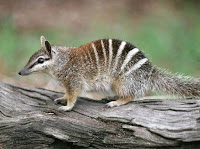 Numbat
NumbatThe numbat, Myrmecobius fasciatus, is an endangered marsupial that lives in southwestern Australia, often in eucalyptus groves. Numbats use their sensitive noses and sticky tongues to find and eat insects, especially termites. During the winter months they warm themselves by basking in the sun. Australians have created captive breeding colonies for numbats in hopes of ensuring their survival.
 Pangolin
PangolinFour species of terrestrial and arboreal pangolins are found in forest and open savanna habitats of Africa and southern Asia. Entirely covered with large, brown, overlapping scales, the pangolin is well protected against predators. When threatened, the pangolin rolls into a tight ball, causing the sharp, free edges of the scales to rise. Pangolins eat ants and termites, which they lap up with their long, sticky tongues.
 Platypus
PlatypusThe duck-billed platypus, Ornithorhynchus anatinus, found only in eastern Australia, lives in streams, rivers, and occasionally lakes with year-round water. It feeds mostly on bottom-dwelling aquatic insect larvae, which it finds by probing the streambed with its pliable, sensitive bill. It grows to a maximum size of 1 to 2.4 kg (2.2 to 5.3 lb). One of only a few venomous mammals, the male platypus has a poison gland in the hind leg that opens through a bony spur on the ankle. The spur is used to defend against predators and possibly to defend its territory against other males. The females lack the venom gland and bony spur.
 Polar Bear
Polar BearPolar bears congregate on the snow-covered shores of Hudson Bay in northeastern Manitoba. All of Manitoba’s rivers and streams drain into the Bay, where the fishing is good for polar bears.
 Pronghorn
PronghornThe pronghorn is one of the fastest mammals on earth, reaching a maximum speed of 86 km/hr (55 mph) and a sustained speed of 70 km/hr (45 mph). Native to the open grasslands and brushlands of the western United States, Canada, and Mexico, the pronghorn feeds on crops and a variety of wild plants. The pronghorn’s eyes are set far out on the skull, allowing for a 360-degree field of view.
 Red Wolf
Red WolfThe red wolf, Canis rufus, is smaller than its close relative, the gray wolf. Virtually extinct in the wild, the United States Fish and Wildlife Service is breeding red wolves in captivity. They have had mixed success when the captive-bred red wolves were released into two wilderness sites within their native habitat in the southeastern United States. Some wolves were able to thrive while others died.
 Reindeer
ReindeerThe reindeer inhabits the far northern reaches of Europe and Asia, as well as North America, where the animal is called a caribou. Although the population of reindeer has declined, some nomadic tribes in North Asia and Europe and northernmost North America still follow the herds, using the flesh of the animals as food and their antlers as tools and utensils. Massive assymetrical antlers grow on both male and female reindeer; the female reindeer is the only type of female deer to have antlers.
 Ring-Tailed Lemurs
Ring-Tailed LemursThe ring-tailed lemur, Lemur catta, is found only on the island of Madagascar and the nearby islands of Comoros. Adults of this species grow to 38 to 43 cm (15 to 17 in) in length and can reach weights of nearly 4 kg (9 lb). Their habitat ranges from tropical deciduous forest to semi-desert, and they are comfortable both on the ground and climbing trees.
 Short-Beaked Echidna
Short-Beaked EchidnaEchidnas are monotremes, or egg-laying mammals. The female deposits a single egg in her pouch while lying on her back. The egg hatches only about ten days later, but a young echidna stays in its mother’s pouch, feeding from milk “patches,” until its spines begin to develop. An echidna’s spines are its protection. If threatened, the animal curls up in a ball, offering a mouthful of sharp spikes to its attacker. On soft soil, it will use its long foreclaws to bury itself and escape heat and disturbances. The short-beaked echidna is Tachyglossus aculeatus.
< more pictures >
